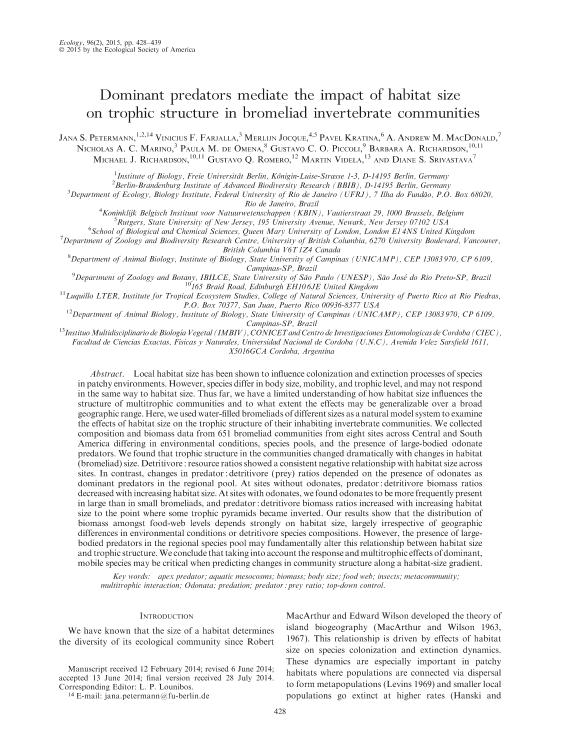Artículo
Dominant predators mediate the impact of habitat size on trophic structure in bromeliad invertebrate communities
Petermann, Jana S.; Farjalla, Vinicius F.; Jocque, Merlijn; Kratina, Pavel; Macdonald, Andrew; Marino, Nicholas; de Omena, Paula; Piccoli, Gustavo; Richardson, Michael; Richardson, Barbara; Romero, Gustavo; Videla, Martin ; Srivastava, Diane
; Srivastava, Diane
 ; Srivastava, Diane
; Srivastava, Diane
Fecha de publicación:
07/2014
Editorial:
Ecological Society Of America
Revista:
Ecology
ISSN:
0012-9658
Idioma:
Inglés
Tipo de recurso:
Artículo publicado
Clasificación temática:
Resumen
Local habitat size has been shown to influence colonization and extinction processes of species in patchy environments. However, species differ in body size, mobility, and trophic level, and may not respond in the same way to habitat size. Thus far, we have a limited understanding of how habitat size influences the structure of multitrophic communities and to what extent the effects may be generalizable over a broad geographic range. Here, we used water-filled bromeliads of different sizes as a natural model system to examine the effects of habitat size on the trophic structure of their inhabiting invertebrate communities. We collected composition and biomass data from 651 bromeliad communities from eight sites across Central and South America differing in environmental conditions, species pools, and the presence of large-bodied odonate predators. We found that trophic structure in the communities changed dramatically with changes in habitat (bromeliad) size. Detritivore : resource ratios showed a consistent negative relationship with habitat size across sites. In contrast, changes in predator : detritivore (prey) ratios depended on the presence of odonates as dominant predators in the regional pool. At sites without odonates, predator : detritivore biomass ratios decreased with increasing habitat size. At sites with odonates, we found odonates to be more frequently present in large than in small bromeliads, and predator : detritivore biomass ratios increased with increasing habitat size to the point where some trophic pyramids became inverted. Our results show that the distribution of biomass amongst food-web levels depends strongly on habitat size, largely irrespective of geographic differences in environmental conditions or detritivore species compositions. However, the presence of large-bodied predators in the regional species pool may fundamentally alter this relationship between habitat size and trophic structure. We conclude that taking into account the response and multitrophic effects of dominant, mobile species may be critical when predicting changes in community structure along a habitat-size gradient.
Palabras clave:
Apex Predator
,
Aquatic Mesocosms
,
Biomass
,
Body Size
Archivos asociados
Licencia
Identificadores
Colecciones
Articulos(IMBIV)
Articulos de INST.MULTIDISCIPL.DE BIOLOGIA VEGETAL (P)
Articulos de INST.MULTIDISCIPL.DE BIOLOGIA VEGETAL (P)
Citación
Petermann, Jana S.; Farjalla, Vinicius F.; Jocque, Merlijn; Kratina, Pavel; Macdonald, Andrew; et al.; Dominant predators mediate the impact of habitat size on trophic structure in bromeliad invertebrate communities; Ecological Society Of America; Ecology; 96; 2; 7-2014; 428–439
Compartir
Altmétricas



